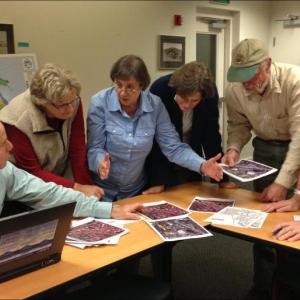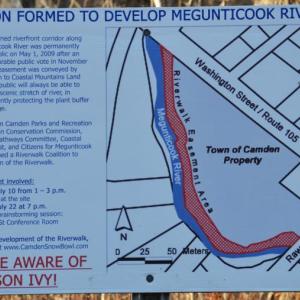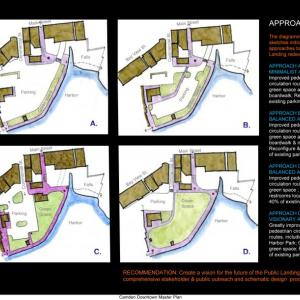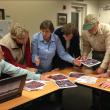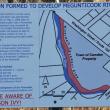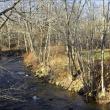Camden plans new trails, selects design engineers
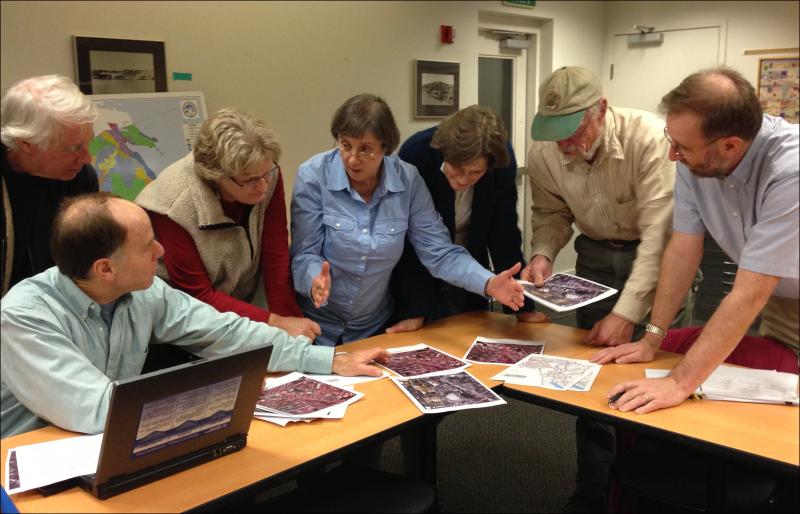 The Camden-Rockport Pathways Committee meets the first Wednesday of each month, either at the Rockport or Camden town office. On Dec. 5, committee members convened in Rockport, with Anita Brosius-Scott and Geoff Scott, of Camden; Robert Davis, of Camden; Kathleen Bachus, of Camden; Helen Shaw, of Rockport; Richard Stetson, of Camden; and, Rockport Select Board representative Ken McKinley (Photo by Lynda Clancy)
The Camden-Rockport Pathways Committee meets the first Wednesday of each month, either at the Rockport or Camden town office. On Dec. 5, committee members convened in Rockport, with Anita Brosius-Scott and Geoff Scott, of Camden; Robert Davis, of Camden; Kathleen Bachus, of Camden; Helen Shaw, of Rockport; Richard Stetson, of Camden; and, Rockport Select Board representative Ken McKinley (Photo by Lynda Clancy)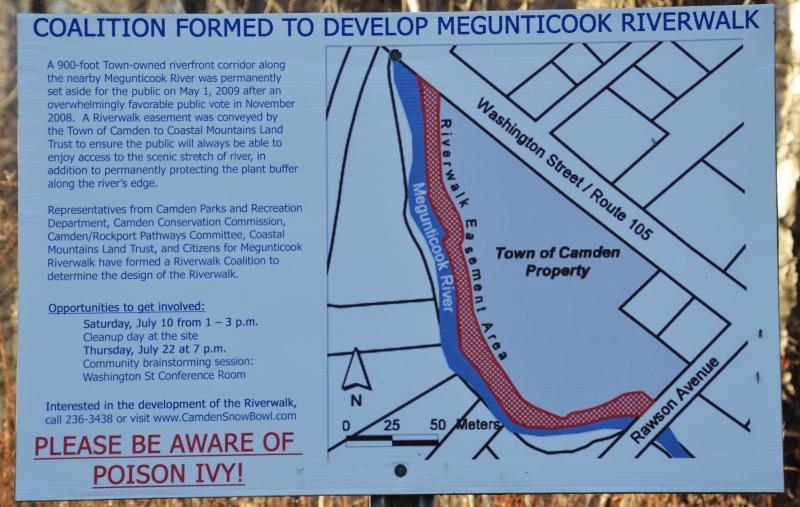
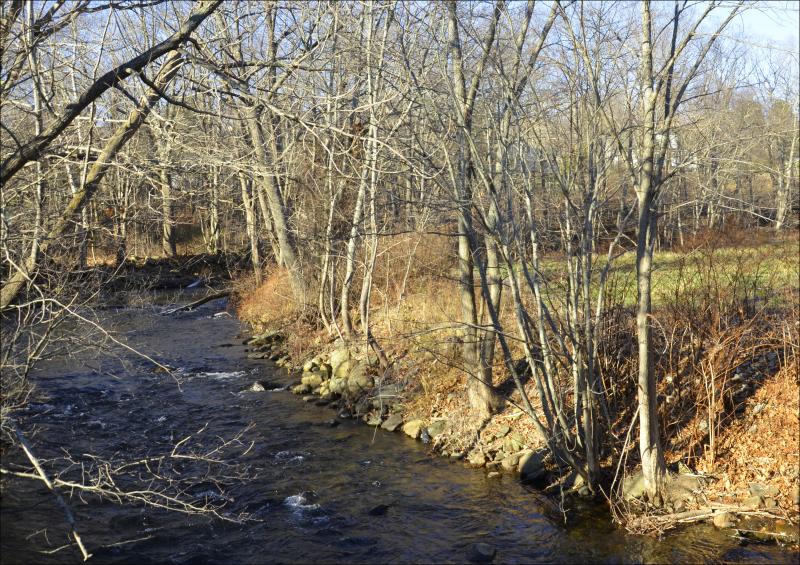 The Megunticook River as it winds along the old tannery property. The pathway would be built on the righthand side of the river at that point. (Photo by Lynda Clancy(
The Megunticook River as it winds along the old tannery property. The pathway would be built on the righthand side of the river at that point. (Photo by Lynda Clancy(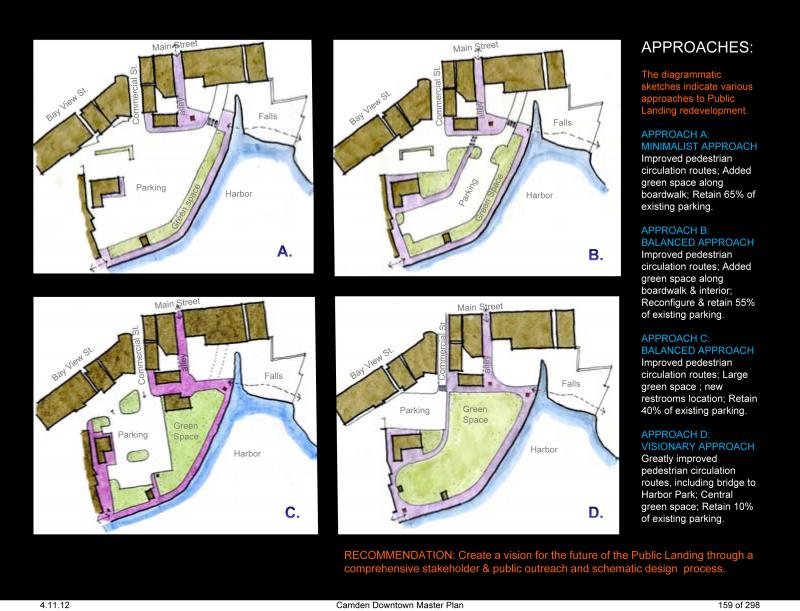
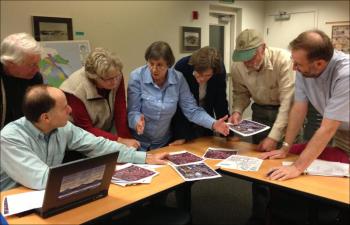 The Camden-Rockport Pathways Committee meets the first Wednesday of each month, either at the Rockport or Camden town office. On Dec. 5, committee members convened in Rockport, with Anita Brosius-Scott and Geoff Scott, of Camden; Robert Davis, of Camden; Kathleen Bachus, of Camden; Helen Shaw, of Rockport; Richard Stetson, of Camden; and, Rockport Select Board representative Ken McKinley (Photo by Lynda Clancy)
The Camden-Rockport Pathways Committee meets the first Wednesday of each month, either at the Rockport or Camden town office. On Dec. 5, committee members convened in Rockport, with Anita Brosius-Scott and Geoff Scott, of Camden; Robert Davis, of Camden; Kathleen Bachus, of Camden; Helen Shaw, of Rockport; Richard Stetson, of Camden; and, Rockport Select Board representative Ken McKinley (Photo by Lynda Clancy)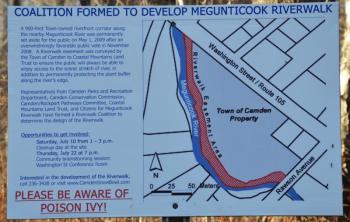
 The Megunticook River as it winds along the old tannery property. The pathway would be built on the righthand side of the river at that point. (Photo by Lynda Clancy(
The Megunticook River as it winds along the old tannery property. The pathway would be built on the righthand side of the river at that point. (Photo by Lynda Clancy(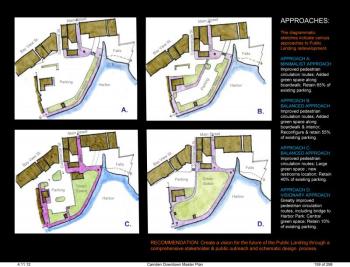
CAMDEN — Wheels of change move slowly, sometimes so slowly the momentum is barely noticed; yet, quietly, indicators build. An idea sparks conversation, which builds into a proposal, and then, if one is persistent, a grant to further the idea gets approved in an obscure state office in Augusta. Suddenly, a community like Camden is talking seriously about a project like the Camden Riverwalk, or an initiative to create bike trails from Ragged Mountain to the harbor, or beyond — even to Spring Mountain — in Rockport.
Ambitious, maybe. But not unheard of in other communities and regions across the country that actively promote outdoor physical activity. Albuquerque, N.M., does it with an extensive Prescription Trails program, doctors prescribing walking routes for patients with maps of walking and hiking trails in that city, and throughout the state, as they try to get a populace outside, moving and healthier. The Upper Valley Trails Alliance in Vermont is connecting alternative transportation and trails throughout portions of Vermont and New Hampshire in the name of health. And, there is the Kingdom Trails Association in Vermont, which established a 100-mile multi-use trail system geared to mountain bikers, but used by others, as well. That system relies on the permission of landowners and businesses, and is referred to often as a model that might be applied to the Midcoast region of Maine.
The creation of trails and pathways has increased dramatically over the past 20 years across the country, and in Canada, as communities convert old railbeds for bikers, walkers and horseback riders. Pivotal was the Congressional transportation legislation passed in 1991. The Intermodal Surface Transportation Efficiency Act articulated the role of bicycling and walking in the country's transportation system and began funneling money toward projects that supported the act.
The goals are multiple: establish means for getting around communities other than by car; encourage citizens to get healthier with exercise — while reducing the strain on public health systems; and to build more liveable communities.
In the Midcoast, various communities have pursued trail and pathways plans with varying levels of success. Most recently, Camden secured several grants and is now at the cusp of putting dreams to paper. This month, Camden will hire designers to produce ideas on how a riverwalk might look, as well as renderings of a revamped Public Landing.
Last fall, the town of Camden secured three state grants: a $15,000 grant (with a required $5,000 matching contribution from the town) to help plan a design for a path alongside the Megunticook River from Shirttail Point to the harbor: another $15,000 grant (and $5,000 local matching contribution) to revision the Town Landing, with tie-ins to the Riverwalk; and the third, to be used to construction of a section of the Riverwalk along the former Apollo Tannery property on Washington Street.
The town subsequently circulated on Dec. 6 a request for proposals to engineers to fulfill the two design grants and now a scoring committee comprising Town Manager Patricia Finnigan, Economic Development Director Brian Hodges, and citizens Carole Snyder, Deb Dodge, Barrie Pribyl, Gene McKeever and Geoff Scott are reviewing 11 proposals. They are targeting Feb. 19 to take a recommendation to the Select Board, which will decide whom to hire. The company that the board ultimately selects will work on both projects outlined in the grants.
The town was clear to say in its RFP: "This request must not be construed as a commitment to award a contract."
In the RFP, Camden said the goal was to develop a schematic site plan for the Riverwalk, with trail elevations, widths, right of way impacts, wetland impacts, structural cross sections, surface material, and information necessary to construct the trail. Regarding the Public Landing, the request is for a schematic site plan identifying the proposed improvements, and three dimensional visual renderings depicting the proposed improvements. An economic benefits analysis of both projects will also be included.
The firms submitting proposals include A.E. Hodsdon, of Waterville; Alta, Boston; Archipelago, Ellsworth; DeLuca-Hoffman Associates, Inc., South Portland; Lachman Architects and Planners, Portland; Milone and MacBroom, Portland; Plymouth Engineering, Inc., Plymouth; Richardson and Associates, Saco; Sewall, Old Town; T. Y. Lin International, Falmouth and San Francisco; and Wright-Pierce, of Portland.
Once a firm is selected, a similar public involvement strategy to that used during the creation of Camden's Downtown Master Plan will begin, according to Hodges. A series of public, community meetings, as well as stakeholder interviews, will be scheduled, and a work group will be formed to guide the designers and town staff. The work group will included one representative from municipal committees, such as CEDAC, Harbor, Conservation Commission, Parks and Recreation, and Pathways, as well as representatives of the Downtown Business Group, Penobscot Bay Area Chamber of Commerce, Knox Mill Condo owner association, citizens, and property owners, said Hodges.
It's about the eco-economy
The enthusiasm for furthering recreational and pedestrian trails and paths throughout the region ran high at a recent joint meeting of the Camden and Rockport select boards. There, the conversation ranged from extending sidewalks pathways along Route 1 through Rockport, and over the Rockport-Rockland town line, to extending a path from Russell Ave., in Rockport, to Chestnut Street, in Camden. The boards emphasized the economic benefits of building a regional identity known for outdoor activity, with trails figuring prominently.
Locally, the effort to create a network of biking trails has been steadily growing with the Midcoast Chapter of the New England Mountain Bike Association. In 2012, the Camden Select Board endorsed a six-month work group, consisting of John Anders, Jeff Kuller, Morgan Laidlaw and Trever Mills, to explore how a public/nonprofit might work together to build a trail network that enhances the local economy.
Working in parallel is the Camden-Rockport Pathways Committee; in particular, dedicated Camden residents and town staff, who worked for several years on the Camden Riverwalk, a concept that includes building a recreational trail along the riverside of the former Apollo Tannery land on Washington Street. The Riverwalk is one section of a larger vision, the River to Harbor Walk, which, if approved and funded, would connect Shirttail Point on the lower end of Megunticook Lake to the harbor, a distance of approximately 2.25 miles. Part of that trail — 750 feet of it — would also hug the river along the Camden-Rockport Middle School campus, behind its ballfields.
From a economic perspective, the paths and trails help feed that growing outdoor recreation sector, the eco-economy, as defined by the town. In 2011, Camden's Community and Economic Development Advisory Committee (CEDAC) rated the Megunticook Riverwalk among the top 10 recommended economic development projects for the town. The regard for this eco-economy, as termed by Gov. Paul LePage, has been growing in Maine, and is targeted by state policy makers as ripe for developing. The University of Maine's School of Economics even now includes a concentration in recreation business management for students interested in outdoor recreation policy and business.
"Outdoor recreation is one of the world's most diverse and fastest growing industries," the university says.
From the transportation perspective, it is, according to the grant application, to "provide a critical link between a smaller satellite business zone [Millville] with the downtown and an alternate shortcut to the middle school." In the 2005 Camden Comprehensive Plan, a section cites construction of a 5,600 gravel pathway along Megunticook River.
The pathways committee consists of Camden and Rockport citizens, working under town government auspices, that has been in existence since 1999 and has the task of building alternative transportation routes across the two towns. (For the record, this writer is a Rockport representative to the committee).
Grant specifics
Last fall, the Maine Department of Agriculture, Conservation and Forestry, which oversees the Maine Coastal Program, awarded Camden with a $15,000 grant to plan and design the River to Harbor Walk. The local match of $5,000 will derive from Camden's Sidewalks and Pathways budget, as approved by the Camden Select Board on Sept. 17. The Public Landing planning grant, also worth $15,000, will be matched locally with $5,000 from the town's Economic Development Reserve Fund.
Besides distributing grants to improve water quality and conserving coastal habitat, part of the Maine Coastal Program intent is to promote sustainable development and enhance coastal-dependent economies while preserving natural coastal resources.
The Walk also creates "greater access between our neighborhoods and downtown, and would connect the various sections of our downtown to one another, culminating at Camden Harbor," said Hodges, community development director for the town of Camden, in a news release that announced securement of the grant. The planning money will help determine the best location for the Walk.
Camden's Public Landing
The Public Landing at the harbor has been paved over for decades, a largely utilitarian parking lot. It is cleared now and then for events, but it serves as catch-all for tourist cars, fishermen trucks, and locals finding a rare parking spot while they run errands.
Over the past few years, there has been an effort to create a new vision for the space, adding more green space, and then this year, the notion of tying its overhaul with a River to Harbor Walk was articulated.
The piers are also used by commercial fishermen and daysailers. "A determination of best uses and redesign of the Public Landing will need to incorporate the needs of these commercial operations and may very well result in a combination of parking and pedestrian focused space," the application said. "Other opportunities to be considered include the means of entry to Camden are not only by vehicle but also by boat via Camden Harbor. However, the view of the downtown from the harbor side is not as comparable as the view from the interior side of the downtown. In addition, there has been a recurring discussion of the possibility of building a connecting bridge from the Public Landing, over the falls, and connecting to Harbor Park."
The Megunticook River cuts down through Camden neighborhoods from Megunticook Lake, on its way to empty into the harbor. In centuries past, large mills sat alongside it, using its water for power. Camden Town Manager Patricia Finnigan said upon receiving the grant that the specific location of the trail has not been decided.
"One of the major purposes of the planning and design process will be to involve citizens to explore various options," she said, in a September news release. "We want the River to Harbor Walk to be a popular trail that the community will use and be proud of."
Specifics of the trail along the tannery property are more defined, however, according to the original grant application to the state. The trail is to:
Accommodate walking, running, mountain biking and dog-walking, and in the winter, cross-country skiing.
Be compliant with the Americans with Disabilities Act, providing a walking trail for people of all levels of physical ability.
The trail is to be of packed stone dust, four to six feet in width, punctuated by a few boardwalk sections designed to improve viewing of the river and facilitate ADA compliance. The two river-viewing areas include one raised boardwalk that is to end in a curbed deck area along the river, allowing wheelchair access, and providing a space to fish; the other is off the main path, railed, and reuses an old concrete foundation pad near the riverbank.
Support for the trail was formally submitted by Coastal Mountains Land Trust, the pathways committee, Camden's Conservation Commission, Friends of Pathways, Penobscot Bay Regional Chamber of Commerce, Penobscot Bay YMCA, Knox County Community Health Coalition and Citizens for a Megunticook Riverwalk.
In the RFPs that circulated in December, Camden was clear to say that there must be community involvement.
"It will be imperative that significant, careful, and sensitive community engagement is incorporated into the recommendations," the town said. "The proposed riverwalk potentially may abut and encroach both public and private property. The Public Landing is a treasured section of Town owned property."
Editorial Director Lynda Clancy can be reached at lyndaclancy@penbaypilot.com; 706-6657.
Event Date
Address
United States

